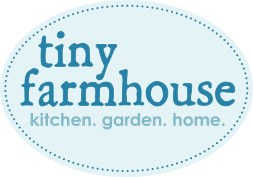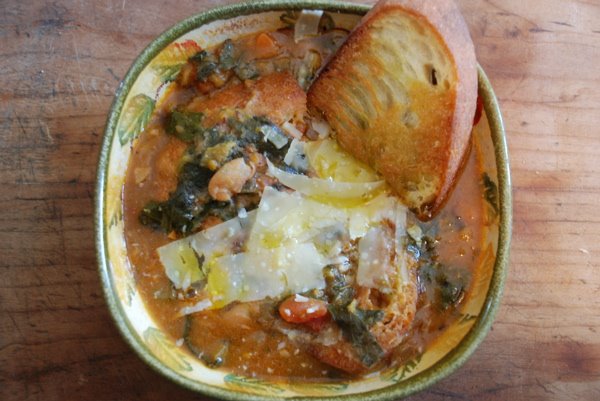If you’ve read any of the previous posts in which I’ve described having Ribollita for dinner, you are already aware that it comes from the tradition of cucina povera, or the poor kitchen – also known as peasant cooking – which was the necessary means of cooking throughout Italy for generations. Many of the dishes of cucina povera were designed to utilize leftovers, hence, Pappa al Pomodoro (tomato and bread soup) was a way to use the previous day’s bread rather than have it go to waste, likewise, Panzanella, a tomato and bread salad was designed for the very same purpose. Ribollita was often made from another leftover soup, and its name translates to “reboiled”, so the soup would literally be recooked and then served over what? Yes, leftover bread.
It is fortuitous for us that those Italian cooks who had no choice but to use every last bit of food in their houses happened also to have fantastic taste. These foods tend to be very tasty despite their humble ingredients, and in many cases, are also quite substantial.
I have made this soup in a variety of ways to determine the easiest method – in the event that you were wondering if I am looking out for your interests, you now know that I am – and it turns out that there is one step at the end that, while seemingly an “extra”, is actually vitally important to the garlicky goodness of the soup. If you don’t love garlic, well, then, it is an extra. But if you, like me, are enamored of garlic, it is mandatory.
Now, let us make the garlicky Ribollita:
Ingredients
- 1 1/2 cups dry cannellini beans or Great Northern beans
- 3 tablespoons extra virgin olive oil
- 1 celery rib, chopped
- 1 carrot, peeled and chopped
- 1 medium onion, chopped
- 1 clove garlic, diced
- 1 tablespoon rosemary, chopped
- 1/4 teaspoon crushed red pepper
- 8 cups water
- (1) 15-ounce can crushed fire-roasted tomatoes
- 1 bunch cavolo nero (also known as "dinosaur kale") or one small head savoy cabbage, chopped.
- 1 tablespoon olive oil
- 1 tablespoon thyme
- 2 cloves of garlic, diced
- kosher salt
- pepper
- a slice of crusty bread for each person partaking of the soup, or - even more in the spirit of cucina povera - leftover bakery bread that you can't believe you let dry out to the point of crouton consistency. If you want your soup to look like the one in the picture above, you may want to toast two slices of bread for each partaking person.
- 1 tablespoon olive oil (more if you are using more than 4 slices of bread)
- 1 large clove of garlic, peeled
Instructions
- The night before you plan to make the Ribollita, rinse the dried beans well, sifting through for pebbles, as beans are from the earth, they sometimes carry bits of earth with them to the grocery store. Once the rinsing water runs clear, place them in a large bowl and cover with cold water. The beans will expand to approximately double their dry size, so resist the temptation to soak them in a small bowl, lest you awake to find beans spilling over the bowl edge and cluttering your counter top. Not a very desirable first event of the day, I'm sure you'd agree.
- Once you are ready to make the Ribollita, drain the beans and set aside. Heat the oil in a large stockpot over medium heat. Add the onion, celery, carrot, and garlic and cook until the onion is translucent and all of the vegetables are softened, approximately 8-10 minutes. Add the rosemary and crushed red pepper and stir to combine. Add the beans and stir to coat with the oil. When the beans are well-coated, add the 8 cups of water and the crushed tomatoes, bring to a simmer, cover, and cook for 1 1/2 to 2 hours, or until the beans are cooked through. Trust me, you will know if a bean is not cooked through. In the name of getting all the answers for you, I have tried a not-thoroughly-cooked bean, and there is no confusing it with a thoroughly-cooked bean.
- Allow the soup to cool slightly. If you have read about or attempted to make either the Roasted Butternut Squash soup or the Roasted Fennel and Carrot soup, you know that pureeing hot liquid in a blender will most certainly result in kitchen walls, counters, cabinets, and any inhabitants of your household who happen to be in the kitchen, to be covered in whatever hot liquid you thought you might be pureeing. I'm sure I don't need to tell you - oh, but I will - this is extremely undesirable.
- Now, that the soup has cooled, use a slotted spoon to remove the beans - at least half, and more than half if you like a thicker soup - to a bowl. There should also be some liquid (as mentioned in the previous paragraph) in the bowl and even some of the vegetables. You can't be sorting out diced celery and carrot pieces prior to pureeing, that would be infuriatingly tedious work. Working in batches, puree the beans and then return them to the stockpot. Once all of the beans you've chosen to puree have been returned to the stockpot, reheat (not reboil - just reheat, but conceptually, you are free to think of it as reboiling if it helps you better connect with your inner practitioner of cucina povera) the soup. Add the cavolo nero or Savoy cabbage at this point. Cook until the cavolo nero or cabbage is cooked through, approximately 20 minutes. Toward the end of the cavolo nero/cabbage cooking time, heat the 1 tablespoon of oil in a small pan over medium heat, add the thyme and garlic, and cook quickly - approximately 2 minutes - until the garlic is good and fragrant. Add the garlicky-thyme mixture to the pot, and give it a good stir. This thyme-garlic saute is the not-extra extra step. You must do it. Trust me. Now, taste the soup and salt and pepper as you desire. I find that Ribollita requires a bit of salt to highlight it's flavor, and kosher salt works best for this task.
- Also during this cavolo nero/cabbage cooking time, you'll want to dry out the bread. Essentially, you are making croutons of the bread, so preheat the oven to 350 degrees. Place the slices of bread on a baking sheet. Drizzle just a little bit of olive oil onto both sides of the bread, they do not have to be doused in oil, a drizzle really will be fine. Bake in the oven until each side is lightly browned, approximately 5 minutes per side. Remove from oven and, using tongs to hold the bread as it will be hot, rub the cut side of the garlic clove over one side of the bread. If you love love love garlic, go ahead and rub both sides of the bread. Your eyes may sting from the heat of the garlic when you bite into your crouton, but, hey, you love garlic, so you already know this.
- Place a slice of bread at the bottom of a soup bowl and ladle out some recooked bean and vegetable soup to submerge your crouton. If you so desire, drizzle a little extra virgin olive oil over top of the soup, and, heck, for good measure, you could even shave some Parmigiano-Reggiano onto the soup before serving, and then serve it forth, not feeling at all like a peasant, but like a very thrifty modern-day cook who just whipped up a very satisfying, tasty, and garlicky zuppa.
Dinner tonight: Roasted Butternut Squash Lasagna. We haven’t had this since before Thanksgiving, and I am only too happy to see it return to my dinner table, scrumptious as it is. Estimated cost for two: $4.24. The milk for the Sauce Bechamel is 25-cents per cup at $1.99 per half-gallon. I used 5 cups, so that’s $1.25. If you happen to buy gallons of whole milk – I do not for they would spoil in my house and you must know that I hate waste after having read all about cucina povera above – the milk would cost $1.09 at $3.49 for 16 cups for the Whole Foods store brand. The butter is 39-cents, the flour is around 6-cents. The rosemary, if purchased – I have a plant sitting in my house because rosemary is JR’s favorite herb – would be about $1.99 for a bunch, and you need about 4 sprigs, so we’ll call that 50-cents. The butternut squash should be no more than 80-cents per pound, so that’s around $1.60. The olive oil used to coat the bottom of the lasagna pan is around 11-cents, and the lasagna noodles are half of a box that cost $1.59, so we’ll round up and call that 80-cents. The largest expense is the Gruyere, but you’re worth it, so go ahead and spend the $11.99 per pound. We’re only using 3/4 pound, so we’ll tally that up as $8.00. The entire lasagna therefore costs $12.71. At my house, this only yields 6 servings, but if you’re light eaters, it could be eight servings. However, we do the math based on what happens at my house, and so each serving is then $2.12.


Hi there Poor Girl! I love your blog–it is so informative! Actually you inspired me (at least in part) to start my own blog at
http://alphabetcook.blogspot.com/
Stop on by!
John
Hi John,
Thank you! I’m glad you like my blog! And that is a pretty darned clever blog you’ve got yourself. What a great idea! I expect that you’ll be in the CHO- part of the alphabet for a little while? Seems like a good spot, what with all the chocolate and all!
Take care,
Amy
I have to get out of the “cho”s…I have eaten pretty much nothing but chocolate cake and torta for a week now. I actually had a couple of others on my list but we are moving on. Ribollita is on the list, but it will be a few months before I get there
Hi John,
Well, by the time you do get to Ribollita, it should be chilly enough for it! Feel free to send cake and torta my way if you can’t bear another bite!
Interessante … avanzi di cibo molto buono dalla sera prima, figlio mio adorato. grazie